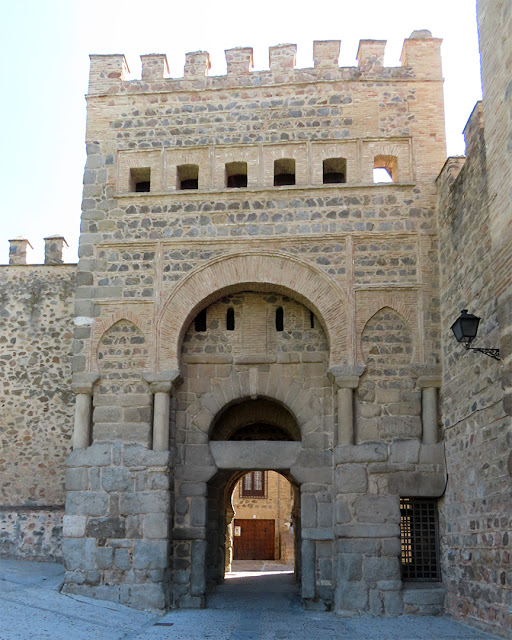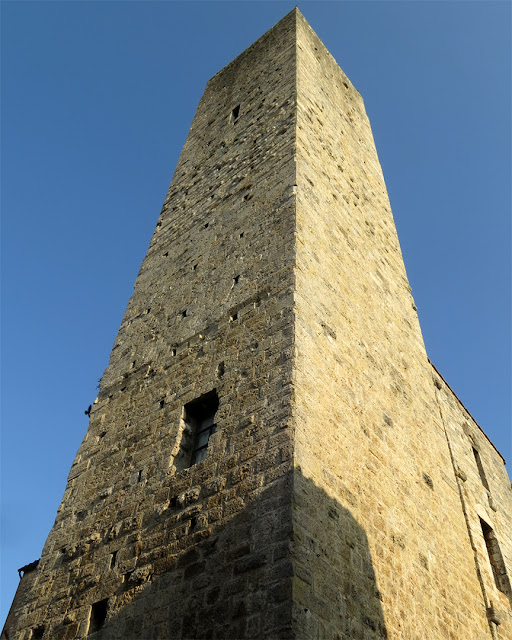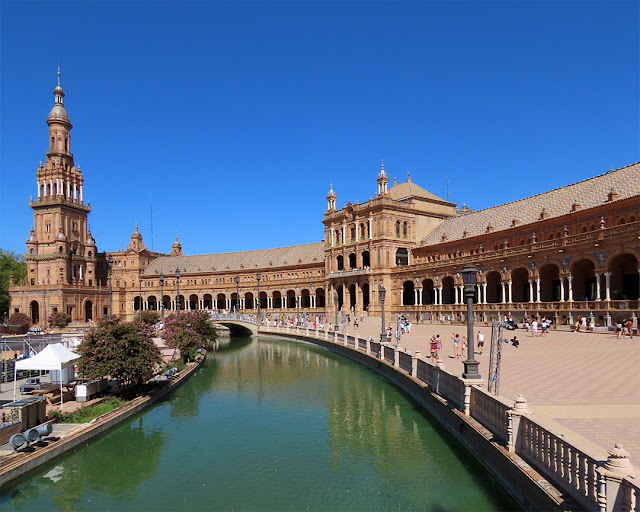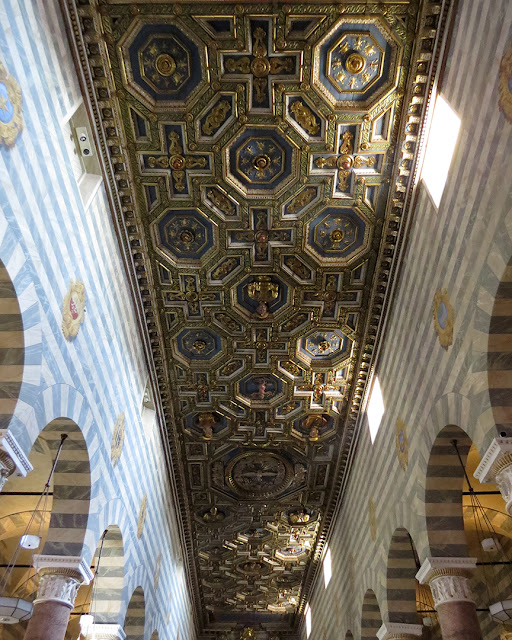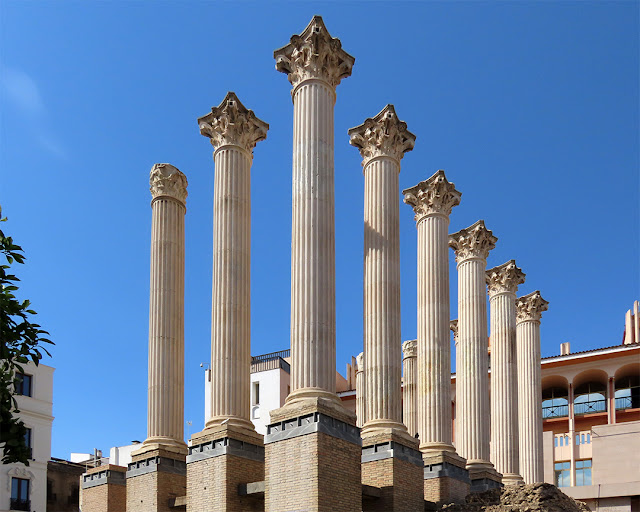Tuesday, January 31, 2023
Torre dei Becci
Torre dei Becci
Piazza della Cisterna
San Gimignano, September 2021
“Its name comes from a water cistern found at the centre of the site, where an octagonal travertine well forms a pivot point in the piazza. It offers a view out through the straight passageway of Arco dei Becci, one of the gates in the ancient medieval wall. Next to the gate are the charming Torri dei Becci and Torri dei Cugnanesi. Nearer the well are very important buildings: the Palazzo Razzi, with its splendid two-light mullioned windows; Casa Salvestrini, which at one time was a hospital and is now a hotel; and Palazzo Tortoli, which is next to the ‘severed’ tower that belonged to the Capitano del Popolo (it was cut down during struggles between rival families).” (Piazza della Cisterna, ItalyGuides.it)
Monday, January 30, 2023
Virgen de los Desamparados
Dome with frescos by Antonio Palomino, 1701
Basílica de la Virgen de los Desamparados
Plaza de la Virgen
Valencia, September 2022
“This temple, built upon the ruins of the Roman forum and dedicated to the patron of the city, is linked to the cathedral by way of a Renaissance arch. Everything inside revolves around the statue of the Virgin, a Gothic sculpture with the head leaning slightly to one side, and covered with a robe and jewels. In the XVIII century, the two innocents who are at her feet were added, and the whole thing is now set upon a mechanical device which allows the statue to revolve. The central nave is covered by an oval-shaped dome, with frescos painted by Antonio Palomino.” (Basílica de la Virgen de los Desamparados, Valencia City Guide)
Sunday, January 29, 2023
Deposition of Christ
“Deposition of Christ” by an unknown Volterran artist, 1228
Cattedrale di Santa Maria Assunta
(Cathedral of Santa Maria Assunta)
Piazza San Giovanni
Volterra, September 2021
“The Chapel of the Deposition has a group of five wooden polychrome figures representing the Deposition of Christ executed in 1228 by an unknown Volterran artist.” (Volterra Cathedral, Wikipedia)
Saturday, January 28, 2023
Puerta de Bisagra
Puerta de Bisagra
Calle Real del Arrabal
Toledo, September 2022
“The Puerta de Bisagra (originally Bab al-Saqra, also called Puerta de Alfonso VI) is a city gate of Toledo, Spain. The structure was constructed in the 10th century, in the time of the Moorish Taifa of Toledo in Islamic Al-Andalus. It is also called 'Bisagra Antigua' to distinguish it from the Puerta de Bisagra Nueva which was built in 1559. The gate was the main entrance to the city and dates from the Moorish period.” (Puerta de Bisagra, Wikipedia)
Friday, January 27, 2023
Torre Chigi
Torre Chigi and Palazzo vecchio del Podestà
Piazza del Duomo
San Gimignano, September 2021
“Located in the heart of the village San Gimignano (UNESCO Heritage) lies a complex tower that holds three hundred residences, incorporates one of the medieval tower internationally famous. Already the famous Useppi family, which later became the property of the family Chigi Saracini. The Chigi Tower is one of the fourteen historic towers of San Gimignano and is located in Piazza del Duomo. The tower, although not very high, is one of the most beautiful in the city. It was built in 1280 and belonged to both the Useppi and Chigi family. The first three floors are covered with stone, well squared cut drafts, which open on the lights with low arches. On the first floor there is a typical portal which is accessed by stairs, the legacy of the struggles of the times of medieval towns, when they preferred to sleep secure building access by withdrawing the first floor stairs at night. On the second floor window is a narrow elongated slot with a bow resting on shelves. The top is covered with bricks instead of two single windows on the same first two floors, while the latter has no openings.” (Historical Palace and tower, Torre Chigi)
Thursday, January 26, 2023
Palacio de Cristal
Palacio de Cristal (Glass Palace) by Ricardo Velázquez Bosco, 1887
Paseo de Cuba
Parque del Retiro
Madrid, September 2022
“The Palacio de Cristal (Glass Palace) is a conservatory located in Madrid's Buen Retiro Park. The Palacio de Cristal, in the shape of a Greek cross, is made almost entirely of glass set in an iron framework on a brick base, which is decorated with ceramics. Its cupola makes the structure over 22 metres high. When it was erected, glass and iron construction on a large scale was already to be seen in Madrid at Delicias station (1880), the work of a French architect; however, the curved architecture of the Palacio de Cristal is more comparable to the techniques pioneered by the British architects Joseph Paxton (who was responsible for London's Crystal Palace) and Decimus Burton (who was responsible for the Palm House at Kew Gardens). The Palacio de Cristal was, alongside the Pabellón Central, one of the main venues of the 1887 Philippines Exposition. The cast-iron frame was manufactured in Bilbao. The structure was designed in a way that would allow it to be re-erected on another site (as happened to the equivalent building in London). However, the building has remained on the original site, next to a lake, and has been restored to its original appearance. It is no longer used as a greenhouse, and is currently used for art exhibits.” (Palacio de Cristal del Retiro, Wikipedia)
Wednesday, January 25, 2023
Madonna dei Chierici
“Madonna dei Chierici” by Francesco Valdambrino, early 15th century
Cattedrale di Santa Maria Assunta
(Cathedral of Santa Maria Assunta)
Piazza San Giovanni
Volterra, September 2021
“The next chapel is the Chapel of the Madonna dei Chierici, referring to a wooden icon of the Madonna, donated by Jacopo di Ciglio (known as il Barbialla), and carved by Francesco di Valdambrino (early 15th century).” (Volterra Cathedral, Wikipedia)
Tuesday, January 24, 2023
Cuesta del Bailío
Cuesta del Bailío (The Bailio Steps)
Calle Alfaros
Córdoba, September 2022
“The central street calle Alfaros leads to the street named Cuesta del Bailío (the Bailio Steps), which was originally one of the entrances of the city walls which connected the Axerquia with the Medina. At the top stands the Casa del Bailío (Bailio House), with its attractive Renaissance façade. This well-loved street leads to the square Plaza de Capuchinos, with the popular statue of Cristo de los Faroles (Christ of the Lanterns) at one end.” (Cuesta del Bailío, Turismo de Córdoba)
Monday, January 23, 2023
Torre dei Cugnanesi
Torre dei Cugnanesi
Via San Giovanni / Via del Quercecchio
San Gimignano, September 2021
“The very high Cugnanesi Tower is another of the 14 survivors in San Gimignano. It stands in a picturesque little piazza near the walls, at the intersection of Via di San Giovanni and Via del Quercecchio. The tower dates from the 13th century and is one of the tallest in the city. Together with the massive Cugnanesi Palazzo, it comprises part of the structure created to defend the nearby Becci Arch. The arch is the town's gateway to the south and leads to the political and religious centre of the town square, communicating between this little piazza and the Piazza della Cisterna. Palazzo Cugnanesi was built around the same time as the tower. Like many medieval buildings, it had a wooden gallery at the first floor that ran around the entire building. All that remains are the brackets that supported it, clearly visible on the upper level. Atop this strong frame is another palazzo with a very strange shape: it looks like a bastion. In actuality, it was a part of the oldest walls of the city.” (Cugnanesi Tower, ItalyGuides.it)
Sunday, January 22, 2023
Las Setas
“Las Setas” (The Mushrooms), Metropol Parasol
Plaza de la Encarnación
Seville, September 2022
“Setas de Sevilla (Mushrooms of Seville) or Las Setas (The Mushrooms), initially titled Metropol Parasol, is a wooden structure located at La Encarnación square in the old quarter of Seville, Spain. It was designed by the German architect Jürgen Mayer and completed in April 2011. It has dimensions of 150 by 70 metres (490 by 230 ft) and an approximate height of 26 metres (85 ft) and claims to be the largest wooden structure in the world. Its appearance, location, delays and cost overruns in construction resulted in much public controversy.” (Metropol Parasol, Wikipedia)
Saturday, January 21, 2023
Arca di Sant'Ottaviano
Marble sarcophagus by Raffaello di Andrea Cioli, 1522
Cattedrale di Santa Maria Assunta
(Cathedral of Santa Maria Assunta)
Piazza San Giovanni
Volterra, September 2021
“In the first chapel, the Chapel of Saint Ottaviano, the relics of this saint are kept in a marble sarcophagus to the right of the altar, sculpted by Raffaello di Andrea Cioli. It was commissioned in 1522 to thank the saint for his intervention in stopping an epidemic of the plague; the candle holders depicting angels are by Andrea Ferrucci.” (Volterra Cathedral, Wikipedia)
Friday, January 20, 2023
Palau de les Arts Reina Sofía
Palau de les Arts Reina Sofía by Santiago Calatrava, 2005
Avinguda del Professor López Piñero
Valencia, September 2022
“Palau de les Arts Reina Sofía (Palacio de las Artes Reina Sofía; anglicised as ‘Queen Sofía Palace of the Arts’) is an opera house, performing arts centre, and urban landmark designed by Santiago Calatrava to anchor the northwest end of the City of Arts and Sciences in Valencia, Spain. It opened on 8 October 2005; its first opera staging was of Beethoven's Fidelio on 25 October 2006. Tenor and conductor Plácido Domingo has maintained a special relationship with the Palau since its founding and has established a young singers training program there.” (Palau de les Arts Reina Sofía, Wikipedia)
Thursday, January 19, 2023
Torre Grossa
Torre Grossa
Piazza del Duomo
San Gimignano, September 2021
“Torre Grossa is the tallest tower in San Gimignano, with 54 m (177 ft 2 in). It is one of the best known of Tuscany's medieval towers. It was built in 1310.” (Torre Grossa, Wikipedia)
Wednesday, January 18, 2023
Cristo de la Luz
Ermita del Cristo de la Luz
Calle Cristo de la Luz
Toledo, September 2022
“The Mosque of Cristo de la Luz is a Catholic chapel and former mosque in Toledo, Spain. It is the one of the ten that existed in the city during the Moorish period. The edifice was then known as Mezquita Bab-al-Mardum, deriving its name from the city gate Bab al-Mardum. It is located near the Puerta del Sol, in an area of the city once called Medina where wealthy Muslims used to live.” (Cristo de la Luz, Wikipedia)
Tuesday, January 17, 2023
Main altar
Main altar with marble ciborium
Cattedrale di Santa Maria Assunta
(Cathedral of Santa Maria Assunta)
Piazza San Giovanni
Volterra, September 2021
“The main altar, mainly dating from the 19th century, has a marble ciborium with flanking angels (1471) by Mino da Fiesole. The choir stalls were completed in the 14th century. In the ceiling of the crossing are depictions of God the Father and Stories of the Life of the Virgin (1585) above the choir by Niccolò Circignani.” (Volterra Cathedral, Wikipedia)
Monday, January 16, 2023
Accidente aéreo
“Accidente aéreo” (Aerial Accident) by Miguel Angel Ruiz, 2006
Calle de los Milaneses
Madrid, September 2022
“The sculptor, Miguel Angel Ruiz, amicably explained to us that his work was neither a Fallen Angel nor Icarus, nor anything of the sort. ‘The work is called Aerial Accident’, he said. ‘The statue is that of a winged Being who has been flying over the Peninsula since time immemorial, for 10,000 years. When he returns after a flight, he flies backwards, looking up at the sky and frolicking with the clouds. Since in olden times there were only wide meadows, he unexpectedly arrives in modern Madrid with its skyscrapers and accidentally hits one of its buildings.’ The bronze statue, with a copper patina, weighs more than 300 kilograms (660 pounds). When it was installed, in January 2006, it had to be positioned with a huge crane from the street and was anchored with great care, since it can sometimes be exposed to high winds and bad weather. The statue was commissioned by the owners of the building, who are friends and clients of the artist. Though the statue may not be Lucifer, it is certainly a curiosity worth seeing.” (Madrid’s Fallen Angels, Madrid Metropolitan)
Sunday, January 15, 2023
Torre del Diavolo
Torre del Diavolo (Devil's Tower)
Piazza della Cisterna
San Gimignano, September 2021
“The Devil's Tower, one of the 14 remaining medieval towers in San Gimignano, is located on the northernmost side of the Piazza della Cisterna and is part of the Palazzo dei Cortesi. The tower has a mysterious and unsettling name that is tied to a legend. It is said that upon returning from a trip, the owner noticed with great surprise that the tower was taller than when he left it. This miraculous event was immediately attributed to some diabolical intervention, and so the name of the tower became inextricably linked with the Devil. The other tower has a double doorway that suggests that there was an ancient foot path passing through it. Right below the tower is the Vicolo dell'Oro, where you find the workshops of the ‘hammerers,’ the artisans who vigorously beat gold coin to reduce it to incredibly thin gold leaf, which is then used for painted tables. Looking up you can notice that the upper floor of the tower has several holes in the walls. These received the timbers that held the galleries (equivalent to our balconies) that allowed people to walk outside, from one room to another. Importantly, these were also able to be rapidly dismantled in case of danger, in order to prevent enemies from accessing the tower. It is for this same reason that the windows that open on each floor are just narrow slits. This was typical of the Middle Ages, when defence took priority over aesthetics, comfort, and the brightness of the environment. The top floor would have had a gallery that ran around it as well. This too has only a few supports remaining. Perhaps it was their somewhat sinister appearance that helped fuel the legend.” (Tower of the Devil, ItalyGuides.it)
Saturday, January 14, 2023
Fuente de la Fuenseca
Fuente de la Fuenseca
Plaza de la Fuenseca
Córdoba, September 2022
“1495 are the first known data concerning the Cordoba fountain, located near the street Alfaros. It was originally a small pool with little flow, and was remodeled in 1808. Their final appearance consisted of four pipes and a large pylon in the fresh water will be accumulated. The front, like a steeple, rests on a whitewashed building, highlighting even more the color of the stone. The whole was annexed to the beautiful gazebo near the manor house belonging to the Marquise of Mejorada.” (Fuente de la Fuenseca, Tutto Córdoba)
Friday, January 13, 2023
Pulpit
Pulpit
Cattedrale di Santa Maria Assunta
(Cathedral of Santa Maria Assunta)
Piazza San Giovanni
Volterra, September 2021
“The pulpit has three reliefs depicting the Last Supper, the Annunciation, and the Sacrifice of Isaac, and the lions at the base of the columns are undoubtedly 12th-century works of the Guglielmo school, perhaps carved by the Pisan sculptor Bonamico. Other elements and the alabaster intarsia were added in 1584, when an earlier balustrade was dismantled and the pulpit was reconstructed.” (Volterra Cathedral, Wikipedia)
Thursday, January 12, 2023
Plaza de España
Plaza de España
Parque de María Luisa
Seville, September 2022
“The Plaza de España (Spain Square, in English) is a plaza in the Parque de María Luisa (Maria Luisa Park), in Seville, Spain. It was built in 1928 for the Ibero-American Exposition of 1929. It is a landmark example of Regionalism Architecture, mixing elements of the Baroque Revival, Renaissance Revival and Moorish Revival (Neo-Mudéjar) styles of Spanish architecture.” (Plaza de España, Wikipedia)
Wednesday, January 11, 2023
Torre Rognosa
Torre Rognosa (The Devil's Tower)
Vicolo dell'Oro
San Gimignano, September 2021
“The oldest tower is the Torre Rognosa, in Piazza del Duomo. Belonging to the Gregori and later to the Oti family, it was built in 1200 and it is the second highest tower in San Gimignano. The nickname Rognosa was attributed to it because it was used as a prison and therefore for those who had troubles, ‘rogne’ in italian.” (The Rognosa tower, Hotel Casolare)
Tuesday, January 10, 2023
Puente de la Exposición
Puente de la Exposición by Santiago Calatrava, 1995
Jardín del Turia
Valencia, September 2022
“The Puente de la Exposicion –the white comblike work by Santiago Calatrava– spanning the riverbed between the ancient ashlars of the Puente del Real and the colourful splendour of the Puente de las Flores bridges. Together with the Puente de les Arts and the Puente del Regne, the Puente de la Exposición represents the height of modernity in the face of tradition. With its sloped arch and four lanes of traffic, the Puente de la Exposicion is a faithful representation of what Calatrava strives for with all of his projects: a living work relating to each of its parts. He differentiates it from the cement bridge of the metro station that supports it, thereby transmitting forces in a natural way. Traditionally known as La Peineta (an ornamental comb) on account of its unique shape, the bridge was designed by Valencian architect Santiago Calatrava. It is a harmonious construction that combines a work of engineering with impressive aesthetics. The bridge is built in high-tensile steel and is set on one single span, with a 14-metre high arch running from one end to the other. Also called ‘Puente de la Exposición’ after a former bridge on that site that led to the area of the Regional Exhibition of 1909. Alameda underground station is below.” (Puente de la Exposición, Valencia City Guide)
Monday, January 9, 2023
Coffered ceiling
Coffered ceiling of the nave
Cattedrale di Santa Maria Assunta
(Cathedral of Santa Maria Assunta)
Piazza San Giovanni
Volterra, September 2021
“In 1580, bishop Guido Serguidi, with the approval of Ferdinando I de' Medici, Grand Duke of Tuscany, commissioned the decoration of the intricately coffered ceiling of the nave and crossings, designed by Francesco Capriani, carved by Jacopo Pavolini, and gilded by Fulvo della Tuccia. The ceiling has sculpted reliefs of Saints Ugo, Giusto, Pope Linus, Clemente, Attinea, and Greciniana, round a central symbol of the Holy Spirit.” (Volterra Cathedral, Wikipedia)
Sunday, January 8, 2023
El Transparente
“El Transparente” by Narciso Tomé and his four sons, 1732
Catedral de Toledo (Toledo Cathedral)
Calle Cardenal Cisneros
Toledo, September 2022
“El Transparente is a Baroque altarpiece in the ambulatory of the Cathedral of Toledo. Its name refers to the unique illumination provided by a large skylight cut very high up into the thick wall across the ambulatory, and another hole cut into the back of the altarpiece itself to allow shafts of sunlight to strike the tabernacle. This lower hole also allows persons in the ambulatory to see through the altarpiece to the tabernacle, as if were transparent, so to speak. It was created in 1729-1732 by Narciso Tomé and his four sons (two architects, one painter and one sculptor). The use of light and of mixed materials (marble, bronze, paint, stucco) may reflect the influence of Bernini's Cathedra Petri in St Peter's Basilica, Rome. Its execution was ordered by Diego de Astorga y Céspedes, Archbishop of Toledo. The Bishop wished to mark the presence of the Holy Sacrament with a glorious monument. The monument cost 200,000 ducats and aroused great enthusiasm, even a celebratory poem wherein the monument was acclaimed 'the Eighth Wonder of the World'. Cardinal Astorga y Céspedes is buried at the feet of El Transparente.” (El Transparente, Wikipedia)
Saturday, January 7, 2023
Torri degli Ardinghelli
Torri degli Ardinghelli
Piazza della Cisterna
San Gimignano, September 2021
“The Salvucci's bitterest enemies were the Ardinghelli, Guelfs who traded with Lombardy and the Orient. To compete with the rival family, they built two twin towers similar to the Salvucci's, right on the opposite side of the piazza. The two Torri degli Ardinghelli also had square bases, but they weren't really ‘twins.’ The tower on the right is a bit straighter and has a more austere, ‘medieval’ look, with truly narrow openings. The other is larger and more imposing and has much larger windows.” (Two Towers, ItalyGuides.it)
Friday, January 6, 2023
Torre PwC
Torre PwC by Carlos Rubio Carvajal and Enrique Álvarez-Sala Walter, 2008
Cuatro Torres Business Area
Paseo de la Castellana
Madrid, September 2022
“The Torre PwC, formerly Torre Sacyr Vallehermoso, is a 52-floor, 236-metre-tall (774 ft) skyscraper, completed in 2008, located in Madrid, Spain. Torre PwC is one of four buildings in the Cuatro Torres Business Area. It was designed by Carlos Rubio Carvajal and Enrique Álvarez-Sala Walter and was built by Sacyr Sau. It houses the five-star hotel Eurostars Madrid Tower, which occupies 60% of the tower, with rooms between floors 6 and 27 and at its upper part, a two-storey dining room offering a panoramic view of the city.” (Torre PwC, Wikipedia)
Thursday, January 5, 2023
Duomo di Volterra
Cattedrale di Santa Maria Assunta
(Cathedral of Santa Maria Assunta)
Piazza San Giovanni
Volterra, September 2021
“Volterra Cathedral (Cattedrale di Santa Maria Assunta, or Duomo di Volterra) is a Roman Catholic cathedral in Volterra, Italy, dedicated to the Assumption of the Virgin Mary. It is the seat of the bishop of Volterra. The present church was rebuilt after the earthquake of 1117 that destroyed most of the town, and consecrated by Pope Calixtus II in 1120. Details of the earlier church on the site are not clear, although a church dedicated to Saint Mary is known from the 9th century. This was not the original cathedral, which was dedicated to Saint Peter and located next to the bishop's palace; it was destroyed by the Florentines during a siege in 1472, after which the bishop's seat was transferred to the present cathedral. Nicola Pisano is said to have been involved in further reconstruction in the mid 13th century. The rustic stone façade was built in Romanesque style using spolia from the Roman theater of Volterra in the portal. The intarsia over the door is attributed to Pisano.” (Volterra Cathedral, Wikipedia)
Wednesday, January 4, 2023
Templo romano
Templo romano (Roman temple)
Calle Capitulares
Córdoba, September 2022
“The Spanish city of Córdoba has the remains of a Roman temple, which was discovered in the 1950s during the expansion of City Hall. It is located in the angle formed by the streets Claudio Marcelo and Capitulares. It was not the only temple that the city had, but it was possibly the most important of all, and the only known by archaeological excavation. It is a Pseudoperipterus, hexastyle and of Corinthian order temple of 32 meters long and 16 wide. Its construction began during the reign of Emperor Claudius (41-54 AD) and ended some forty years later, during the reign of Emperor Domitian (81-96 CE). Presumably it was dedicated to the imperial cult. The temple underwent some changes in the 2nd century, reforms that coincide with the relocation of the colonial forum. In the area had already been found architectural elements, such as drums of columns, capitals, etc. all in marble, so the area was known as los marmolejos. This area of Córdoba could become between the 1st century and the 2nd century, as the provincial forum of the Colonia Patricia, title that received the city during the Roman rule.” (Roman temple of Córdoba, Wikipedia)
Tuesday, January 3, 2023
Torri dei Salvucci
Torri dei Salvucci
Piazza delle Erbe
San Gimignano, September 2021
“The Torri dei Salvucci, in Piazza del Duomo in San Gimignano are also called the ‘Torri Gemelle.’ They belonged to the most important Ghibelline family in the city, the Salvucci. They had become rich through usury and commerce. Their massive and powerful appearance is no accident: the towers were meant to show the supremacy of the family to the entire city. When they were built, they were taller than the 51 meters of the Rognosa Tower, but after a regulation in 1255 expressly forbade buildings higher than Rognosa, they were lowered. Both towers have a square base and, like all medieval buildings, are designed for defence with very few openings. Even the entrance doors are extremely narrow.” (Two Towers, ItalyGuides.it)
Monday, January 2, 2023
Maestranza
Plaza de toros de la Real Maestranza de Caballería de Sevilla
Paseo de Cristóbal Colón
Seville, September 2022
“The Plaza de toros de la Real Maestranza de Caballería de Sevilla is a 12,000-capacity bullring in Seville, Spain. During the annual Seville Fair in Seville, it is the site of one of the most well-known bullfighting festivals in the world. It is a part of the Real Maestranza de Caballería de Sevilla, a noble guild established for traditional cavalry training. The ring itself is considered one of the city's most enjoyable tourist attractions and is certainly one of the most visited. As a stage for bullfighting, it is considered one of the world's most challenging environments because of its history, characteristics, and viewing public, which is considered one of the most unforgiving in all of bullfighting fandom.” (Maestranza, Wikipedia)
Sunday, January 1, 2023
Porta all'Arco
Porta all'Arco
Via Porta all'Arco
Volterra, September 2021
“Porta all’Arco was part of the ancient Etruscan city walls in Volterra. Built in the 4th and 3rd centuries BCE, it has survived to today in all its majesty. The uniqueness of the structure is in the use of stone, of which there are three different colours based on the type of rock used: yellow for the supporting structure, grey for the arch and darker hues for the three mysterious heads. These figures are what have always made the gate fascinating, and there are many legends surrounding them: for some, there’s no doubt they depict Jupiter, Juno and Minerva, while others think they are Castor and Pollux; others still believe they are not human heads, but rather lions watching guard over Volterra. Since the literary saga Twilight was released, additional theories have been suggested, ranging from ones that are historically reliable to those that are more fanciful, like the heads depicting the three vampires from the book that hide in the city.” (Porta all'Arco in Volterra, VisitTuscany)
Subscribe to:
Posts (Atom)




